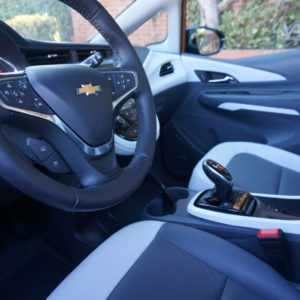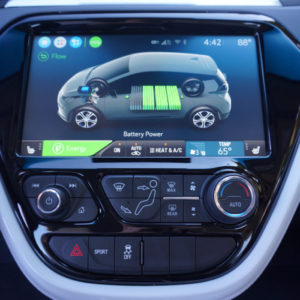As an earlier adopter of an electric vehicle, my daily driver is a 2014 Chevy Spark EV, I was very eager to get a week’s worth of driving in the 2018 Chevrolet Bolt EV. I’ll be honest the Spark EV has a few issues, uncomfortable front seats, limited cargo space and a sweaty palm inducing 80 mile range, which drops much lower if you enjoy burying your right foot. There’s another problem, Chevy engineers decided the Spark should have 140 hp and 400 ft lbs of torque, which causes massive wheel-spin (it’s impossible to drive with the traction control on) even after I switched out the Eco tires for a set of Yokohama’s. Don’t get me wrong it’s an absolute hoot to drive, it’s just a tad impractical for anything other than my 14 mile each way commute.
First launched in 2016 with U.S. sales beginning in California in December 2016, with a nationwide US and Canadian release in 2017. GM sold about 26,000 units globally last year, the vehicle’s first full year of production but this year supply has been an issue and demand is outstripping supply. Sales are now increasing as supplies have been stepped up. Styling is a big improvement over the slightly odd Spark, which was a re-branded Daewoo anyway. The Bolt’s inoffensive exterior is obviously appealing to buyers, it doesn’t shout I’m all electric and futuristic. Instead it’s a boxy upright vehicle which doesn’t look particularly fast, even though it is… I like that.
I had a fleeting drive in a Bolt a year ago but there’s nothing like a week loaner from Chevrolet to really know what this car is like. My 2018 Chevrolet Bolt EV Premier was fully loaded and covered in a many silky coatings of Orange Burst metallic paint, which I had seen before and had put money on it being the color of my press vehicle. Under the hood lies a permanent-magnet electric motor which receives its power from a 60-kilowatt lithium-ion battery, which sits below the floor. The motor delivers 200 horsepower and 266 pound-feet of torque making this car an absolute hoot to drive. Hooked up to our VBox the Bolt bolted from 0-60 in 6.4 seconds, despite some squealing from the not too grippy 17 inch Michelin Eco tires.
Driven carefully the Bolt has an EPA range of 238 miles and it would be possible to exceed that with a careful right foot, the true question is …….can you live with this instead of a gas powered car.
Driving Impressions
Once on the move the Bolt is ridiculously easy to drive, the steering is light, albeit with little feedback and the suspension is well dampened, ironing out the worst of San Diego roads. Acceleration is so much fun, it’s always available and even if you mash the go pedal there is only a modest complaint from the Eco tires. That said I would change them for a set of sportier summer rubber immediately. At freeway speeds you still have plenty of acceleration but it loses steam past 80 and won’t do more than 91 mph due to the limiter. Darting through rush hour traffic is its skill and there aren’t too many gas powered cars than can keep up. It’s small and nimble enough to squirt through gaps without thinking twice and there’s always enough for a highway passing maneuver.
Adding more grin inducing fun is the unique regenerative braking setup General Motors uses. Instead of tying the system to the regular disc brakes, GM’s engineers came up with two options, a special drive mode that enables one pedal driving by activating the regenerative braking as soon as you lift off the throttle, which will virtually bring you to a stop. Additionally there is a steering wheel paddle that gives you that power on demand, like a hand operated brake, which will completely stop the car. It is so much fun to see how long you can drive for without using the brakes. It truly is a one pedal car.
Interior
It’s quite airy in the Bolt and the upright boxy shape provides good headroom front and rear as well as great visibility. The front seats are comfortable, a vast improvement on the Spark EV, however, no power adjustment is offered, presumably to keep costs and weight down. The standard 10.2-inch touch screen runs Chevrolet’s MyLink infotainment operating system and it’s a doddle to use, pairing is a cinch and as a bonus my Premier tester had heated leather seats and steering wheel, drivers aids like blind spot monitoring, rear cross-traffic alert, and a 360-degree camera. Pedestrian detection also makes sense for a car that is virtually silent, the dash displaying an outline of a person who happens to be too close to the road. The seven-speaker Bose sound system sounded pretty good and the temperature controls were my favorite, being in the shape of a person, so easy to use without too much distraction.
Trunk space has gone up from 9.6 ft³ in the Spark to a more useful 16.9 ft³ in the Bolt but you still don’t get a spare wheel, instead a small compressor and some foam. The only real complaint inside is the fiddly shifter which requires an unnecessary button press to select gears, it’s over-complicated and fussy. That said the pros easily outweigh the cons, this is a really terrific little car.
Conclusion
Having owned a Spark EV since 2014 I may be a tad biased but the Bolt is really a couple of tweaks away from being perfect. Considering that most people spend a lot of their time doing zero mph, this car makes perfect sense. Add to that virtually no running costs, there’s no oil, no radiator, no fuel pump, in fact you only really need to rotate the tires and charge it up. According to Repair Pal a gas powered Chevy Spark would cost an average of $411 per year in routine maintenance, which is over $1,200 in 3 years.
At about $35,000 after the federal tax credit, the 2018 Chevrolet Bolt Premium is a bargain compared to anything available from Tesla. If I needed a new car this would be it, but unfortunately for service departments my Spark EV is probably going to last me a good while longer.
2018 Chevrolet Bolt EV Numbers
BASE PRICE: – $40,905
AS TESTED PRICE: – $43,905
VEHICLE LAYOUT: – Electric Drive Unit, FWD, 4-passenger, 5-door wagon
ENGINE: – Permanent magnet electric motor
BATTERY: – 60.0 kWh lithium-ion
CHARGE TIME: – 9.3 hrs (240v) – DC Fast Charge: Up to 90 miles in 30 minutes
POWER: – 200 hp
TORQUE: – 266 lb.ft @ 0 rpm
TRANSMISSION: – Electronic Precision Shift
CURB WEIGHT: – 3,563 lb
0-60 MPH: – 6.36 seconds
EPA CITY/HWY: – 128/110 MPGe
DRIVING RANGE: – 238 miles
CARGO SPACE: – 16.9 ft³
PROS: – Fast, Impressive regenerative braking, nimble handling
CONS: – Needs non eco tires, fiddly shifter



















